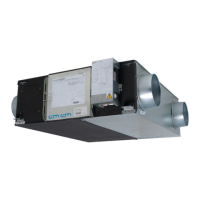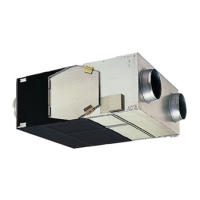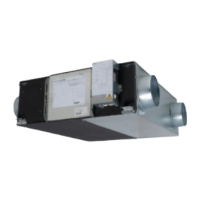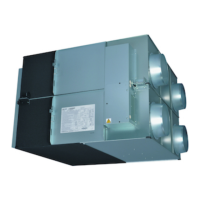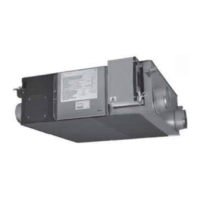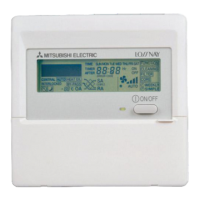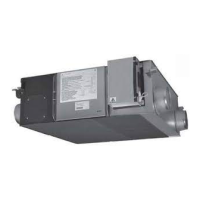
Do you have a question about the Mitsubishi Electric Lossnay series and is the answer not in the manual?
| Frequency | 50/60 Hz |
|---|---|
| Installation | Wall-mounted, ceiling-mounted |
| Application | Residential, Commercial, Industrial |
| Phase | Single-phase |
| Dimensions | Varies by model |
| Weight | Varies by model |
| Control Options | BMS integration |
| Voltage | 100-240 V |
Explains the importance of ventilation for oxygen supply, air cleanliness, and temperature control.
Details the effects of oxygen deficiency and carbon monoxide on human health and safety.
Discusses indoor air quality issues like dirtiness and its relation to ventilation standards.
Defines ventilation performance parameters like air volume and wind pressure.
Provides formulas and data for calculating ventilation load in US and SI units.
Analyzes ventilation load components during cooling in office buildings.
Analyzes ventilation load components during heating.
Describes the basic construction of Lossnay units and their main features.
Explains the structure, principle, and properties of the Lossnay core.
Details methods for calculating temperature, humidity, and enthalpy recovery efficiencies.
Defines terms and parameters used in psychrometric charts for air properties.
Illustrates air conditions and calculation of heat recovered using the Lossnay core.
Compares energy recovery and ventilation load of Lossnay vs. HRV and conventional ventilators.
Provides methods to assess the economic benefits and cost savings of using Lossnay.
Presents a psychrometric chart for US units, illustrating air properties.
Presents test results on the Lossnay core's resistance to bacterial cross-contamination.
Details the fire retardancy test results for the Lossnay core material.
Reports on tests evaluating the sound reducing properties of the Lossnay core.
Analyzes changes in Lossnay core performance after extended operational use.
Compares features and usability of static-type vs. rotary-type energy recovery units.
Guides on interpreting characteristic curves related to static pressure loss.
Explains how to read air volume-static pressure curves and calculate duct pressure loss.
Details how to obtain energy efficiency values using characteristic curves.
Discusses sound levels, auditory perception, and measurement methods.
Presents Noise Criteria (NC) curves for various Lossnay models under different conditions.
Specifies recommended operating conditions and special environment considerations.
Provides sound level data for Lossnay units tested in an anechoic chamber.
Recommends mounting air filters for cleaning air and preventing core clogging.
Offers guidelines for ductwork construction to prevent frost, condensation, and rainwater entry.
Lists transmission rates of gases and their maximum workplace concentrations.
Details the solubility of various gases and their impact on the Lossnay core and usability.
Explains the effects of automatic damper mode and bypass ventilation under various conditions.
Covers top/bottom reverse installation and advises against vertical/slanted installations.
Discusses installing additional fans in ductwork to overcome static pressure from extra components.
Case study of a large office building ventilation system design and requirements.
Case study of ventilation system design for a small-scale urban building.
Case study on hospital ventilation system design for disease transmission prevention.
Case study on school ventilation system focusing on comfort and energy saving.
Case study for hotels handling large load fluctuations, smoke, and odor removal.
Case study for public halls requiring zone control and energy conservation.
Installation diagrams and notes for LGH-Series ceiling embedded-type Lossnay units.
Provides options for outside duct (OA, EA) piping direction for alternative installations.
Key points for installation, including inspection holes and insulation, and basic maintenance.
Illustrates applications like installing two units to one duct and system operation with indoor units.
Highlights the necessity of clean air for comfort and health, and preventing pollen entry.
Shows aerosol particle diameters and applicable filter ranges, with dust concentration data.
Presents effectiveness of filters in terms of collection ratio vs. particle diameter.
Compares gravitational, colorimetric, and counting methods for dust collection efficiency.
Provides formulas to determine indoor dust concentration based on system performance.
Discusses the Lossnay core's durability, lack of moving parts, and lifetime test results.
Provides step-by-step instructions for removing and cleaning air filters and Lossnay cores.
Summarizes ventilation standards in Japan related to building laws and air quality.
Details ASHRAE Standard 62-2010 minimum ventilation rates for various occupancy categories.
Presents CIBSE recommended and minimum outdoor air ventilation rates per person and area.
Addresses questions about the material's life span, insulation properties, and humidity recovery.
Explains energy saving benefits, performance comparisons, and cost factors.
Discusses odor transfer, air leakage rates, and proper placement of intake/exhaust grilles.
Covers usage in extreme cold, clogging prevention, and general operational questions.

